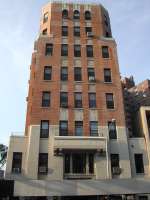INDEX OF YAHRZEIT CARDS
FROM THE BIALYSTOKER CENTER IN NEW YORK CITY
|
CONTENTS |
| The Database This database is now online and contains 3,984 index entries from Yahrzeit Cards maintained by The Bialystoker Center in New York City from about 1880 through about 1994. Many Jews -- Bialystokers and non-Bialystokers alike -- memorialized their departed relatives and friends with Yahrzeit plaques in the Center's sanctuary and community rooms. The Yahrzeit Card was a record of the person's death and also served as an administrative reference enabling the Center's office to send notifications of upcoming Yahrzeits to relatives and friends of the departed. These Memorial Reference Cards include the following data fields:
The following data elements are included in the index:
The Index can be accessed in two ways:
This Excel file will also be submitted to JewishGen for inclusion in the All Poland Database.
ACCESS THE DATABASE
Based on a sampling of the cards for surnames starting with A through H, the deaths covered by these cards range from the 1880s through to about 1994. Some of the people memorialized died in Europe, with some being Holocaust Martyrs. Please keep in mind that not all the people memorialized were Bialystokers and the cards do not give any indication of these people's ancestral homes.
For people or surnames that you will recognize as Bialystokers, these cards are a goldmine of information. Some of these cards will show four generations of names and addresses -- the deceased father and possibly spouses, siblings, children, and grandchildren. These names and addresses are listed as people to be notified annually of the Yahrzeit date of their loved one. Also, many of the cards show the married names of sisters, daughters, and granddaughters, information usually not found on most genealogically relevant records.
A few samples can be found by clicking the following links:
To obtain a JPEG images of Yahrzeit cards, please email Mark Halpern at bialystoker@comcast.net with the full names of the memorialized people and their dates of death. Please place "Yahrzeit" in the subject of the message.
The Bialystoker Center Yahrzeit Card indexing project was a three step endeavor.
Step 1: Using instructions provided by BIALYGen, the following volunteers scanned between 300 and 500 cards each and placed the images on CD.
Step 2: All the scans of all the cards were consolidated onto one CD.
Step 3: Sid Zabludoff from Washington, DC, USA entered the English language index information into an Excel spreadsheet using a template designed for this specific project. The database was then passed on to Kathryn Wallach of New York, USA who entered the Hebrew language information.
BIALYGen thanks all of the volunteers mentioned above as well as Gary Mokotoff for arranging the acquisition of the Yahrzeit Cards from the Bialystoker Center. And lastly, a big THANK YOU to the Bialystoker Center and Barry Winston, President, Alys Kremer Grossman, Vice President, and Daniel Muskin, Administrator for their help and support.
BIALYGen and the Bialystoker Center
In 2003, BIALYGen contacted the President of the Bialystoker Center and presented a proposal to the Board of Directors to publish on the Internet the English language portion of The Bialystoker Memorial Book, published by the Bialystoker Center in 1982 and to organize and gain access to the "Archives" of the Landsmanschaft.
Both these proposals were accepted by the Bialystoker Center Board. The scanning of The Bialystoker Memorial Book is complete and the Internet version of the book can be found on Ada Holtzman's Zchor website at http://www.zchor.org/bialystok/yizkor1.htm. A Surname index, created by BIALYGen volunteers, is also online.
In 2004, a BIALYGen team of Gary Mokotoff, Steven Siegel, Kathryn Wallach, and Mark Halpern visited the Bialystoker Center to survey the "Archives" of the Landsmanschaft. In a storage room in the basement of the Medical Building of the Center, we found five or six card files with family information for the Yahrzeit plaques that can be found in the Center's sanctuary and other community rooms.
Gary Mokotoff then worked with the Center to gain approval for BIALYGen to scan all the cards (there are approximately 5,000 cards with information on nearly 4,000 individuals), create an index, and place the index on the Internet. We received Center authorization and took possession of the cards in April 2005.
Communal Life of Bialystoker Jews in America started in New York in 1897 when the Bialystoker Bikur Cholim was founded. In 1919, David Sohn established the Bialystoker Relief Society, which eventually became the "Federation" of all Bialystoker organizations. This led to the establishment of the Bialystoker Center in New York, the headquarters for Bialystok Landsleit all over the world. In 1926, planning for the Bialystoker Home for the Aged and the Bialystoker Center began and in May 1931 the current building (see photo below) was completed at 228 East Broadway in the Lower East Side of New York. The Bialystoker Center headquarters was also in the building.
Today, the Bialystoker Center & Home for the Aged still functions and is run by a Board of Directors of second and third generation Bialystokers. The Landsmanschaft, the Bialystoker Center, has become inactive. The main focus is the running of the Home for the Aged. The Home now houses over 300 residents. Over half are Jewish, but few are Bialystokers.
|
